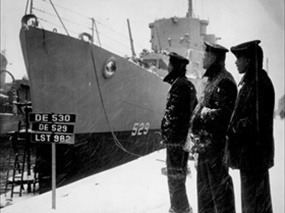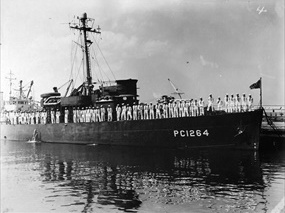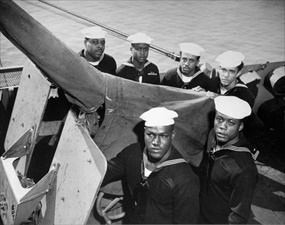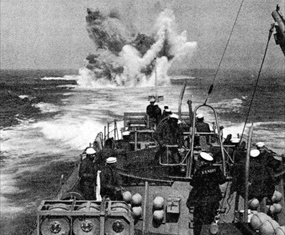USS MASON BREAKS NAVY COLOR BARRIER
Boston Navy Yard, Massachusetts • March 20, 1944
On this date in 1944 the USS Mason, an Evarts-class destroyer escort, was commissioned at the Boston Navy Yard, 5 months after her keel was laid down. The next month, on April 25, 1944, the USS PC‑1264, a PC‑461-class submarine chaser, was commissioned 6 months after her keel was laid down in Morris Heights, New York. Both ships are notable for being the only 2 U.S. warships to have a predominately African American crew. Also notable was that neither warship ever engaged the enemy in combat, Mason pulling dangerous convoy escort duty in the Battle of the Atlantic, PC‑1264 assigned to “shallow-water” service escorting convoys from North America south to the Caribbean and South America.
On December 9, 1941, one day after the United States declared war on the Empire of Japan for its deadly surprise attack on the U.S. Pacific Fleet riding at Sunday morning anchor at Pearl Harbor, Hawaii, the premier American civil rights organization commonly known by the initials NAACP sent a telegram to U.S. Secretary of the Navy Frank Knox, petitioning the Navy to accept African Americans in service other than as lowly mess attendants, i.e., cooks and stewards. After all, Knox’s counterpart, Secretary of War Henry L. Stimson, had months before authorized armored warfare (tank) and flight training for black soldiers and fliers; now it was the Navy’s turn—certainly in this time of existential crisis—to open higher-skilled ratings for black sailors.
Knox refused the NAACP’s request and so did an advisory committee recommended by U.S. President Franklin D. Roosevelt. Roosevelt, or probably First Lady Eleanor Roosevelt, who was an NAACP national board member, pushed back, instructing the Navy secretary to “find something that colored enlistees could do in addition to the rating of messman.” More pushback from Navy brass unless “so ordered,” they replied cautiously. “So ordered,” responded the Commander in Chief of the U.S. Armed Forces. So, beginning on June 1, 1942, African Americans were permitted to enlist for “general service” in the U.S. Navy. Which meant the way was open—on an extremely circumscribed basis—for African American volunteers (but not draftees) to serve aboard exactly 2 U.S. vessels: USS Mason (one of more than a thousand wartime DEs to fly the U.S. naval standard) and the subchaser USS PC‑1264. But (and here was the rub) black servicemembers were not eligible to become commissioned naval officers, the Navy’s General Board opined, because of the paramount need to maintain “the highest level of the fighting efficiency of the Navy.” The General Board proposed several areas (e.g., shore and dock installations, construction battalions, and local defense vessels) where black sailors could be used “with least disadvantage.” Rating limitations were swept aside on May 2, 1945, when Ensign (and future Vice Admiral) Samuel Lee Gravely, Jr., reported for duty aboard PC‑1264, eventually becoming the ship’s executive officer.
Noncommissioned officers were a brighter story for the wartime navy—if only for PC‑1264 in this early, toe-in-the-water experiment of racially integrating U.S. Navy ships. Lt. Eric Purdon, skipper of the tiny 65‑man subchaser, ensured that white petty officers, each assigned to 1 of 8 military occupational specialties (navy MOS, or career ratings) on the PC‑1264, train their replacements chosen from the nonsteward enlisted ranks. Within 6 months of the subchaser’s commission, African Americans were trained in their new ratings and promoted to the rank of petty officer. The redundant white petty officers were transferred off ship in early November 1944, which made the PC‑1264 the only warship in the American navy to have a completely black crew. The Mason’s skipper, on the other hand, Lt. Cmdr. William Blackford, never promoted any of his nonsteward enlistees to petty officer rank, even after he reassigned all chief petty officers off his ship for racial bigotry.
Proudly They Served: The Men of the USS Mason and USS PC‑1264
 |  |
Left: Three African American seamen serving on destroyer escort USS Mason (DE‑529) proudly look over their ship on a cold, wintery day in 1944. Named after the first African American naval pilot, the USS Mason beat submarine chaser USS PC‑1264 by 1 month for the title of being first to break the Navy’s color barrier with a predominantly black crew. Skippered by Lt. Cmdr. William “Big Bill” Blackford (USNR), the great grandson of an abolitionist, the Mason was nicknamed “Eleanor’s Folly,” a joker’s reference to President Roosevelt’s wife, a vocal advocate of desegregation of the armed forces. In its 6 transatlantic convoy crossings, the Mason was tasked with ensuring that the ships it escorted delivered their cargoes of food, fuel, war material, and personnel safely to their destinations in Europe, the British Isles, the Azores, and Northwest Africa. Fifty years after the end of the war the surviving Mason seamen were awarded letters of commendation for their meritorious service and steadfast devotion to duty. Mason’s story is told in the 2006 feature film Proud, starting Ossie Davis. Today’s guided missile destroyer USS Mason (DDG‑87) was named in honor of the ground-breaking African Americans of the World War II crew. Over 150,000 African Americans out of 4,183,466 officers and enlisted personnel served in the U.S. Navy during the Second World War (December 7, 1941, to December 31, 1946).
![]()
Right: Officers and crew of USS PC-1264 pose for a photograph. Five officers are visible on the bridge (center in photo but hard to see). The photo may have been taken after early November 1944 because no white petty officers appear on the bridge, the white officers having been transferred off the submarine chaser in early November. The performance of predominantly black crews on PC‑1264 and USS Mason in this tiny “racial integration experiment,” as it was seen, led the Navy to reevaluate its preconceived perceptions of African Americans as permanent lower rating members of the fleet. The practice of segregated service units only ended in 1948 when President Harry S. Truman issued Executive Order 9981, which racially integrated the U.S. armed services.
 |  |
Left: Gunner mates on the USS Mason pose by one of the ship’s covered 3 in/7.62 cm deck guns. Crewmembers of the USS Mason never fired their guns (there were 16) in anger, supported an amphibious assault on a hostile shore, or attacked an enemy submarine. Yet the ship’s place in U.S. history is assured because it was the first Navy warship with a 95 percent African American crew that excelled at its expanded duties at a time when most black sailors performed low-level, demeaning tasks. Skipper Blackford bragged in a letter home: “Am delighted with the colored men who are here. . . I think the crew is better than average . . . They are anxious to make a name for themselves and actually work harder.”
![]()
Right: A depth charge explodes astern as an officer and seamen of the USS PC‑1264 practice a simulated submarine attack during the ship’s shakedown cruise off Southern Florida in June 1944. Submarine chasers like PC‑1264 were used in the Pacific, Atlantic, Caribbean, Gulf of Mexico, and Mediterranean. Numerous PC‑461-class vessels were used to aid in amphibious assaults, including the 1944 Normandy invasion of Nazi-occupied France. Only one of the 343 subchasers in the PC‑461 class ever sank a submarine, the U‑166 on her second war patrol on July 30, 1942, in the Gulf of Mexico. However, one website cites PC‑461-class ships sinking or assisting in sinking up to 6 German and Japanese subs. Crewmates on PC‑1264 claimed to have damaged U‑866 off New York state as evidenced by an oil slick that surfaced after lobbing multiple depth charges at an elusive target. Crippled, the U‑866 was later sunk off the coast of Nova Scotia, Canada, but Navy records never confirmed PC‑1264’s role in the demise of the U‑boat.
USS Mason: First U.S. Navy Warship in World War II Crewed Mostly by African-Americans
![]()

 History buffs, there is good news! The Daily Chronicles of World War II is now available as an ebook for $4.99 on Amazon.com. Containing a year’s worth of dated entries from this website, the ebook brings the story of this tumultuous era to life in a compelling, authoritative, and succinct manner. Featuring inventive navigation aids, the ebook enables readers to instantly move forward or backward by month and date to different dated entries. Simple and elegant! Click
History buffs, there is good news! The Daily Chronicles of World War II is now available as an ebook for $4.99 on Amazon.com. Containing a year’s worth of dated entries from this website, the ebook brings the story of this tumultuous era to life in a compelling, authoritative, and succinct manner. Featuring inventive navigation aids, the ebook enables readers to instantly move forward or backward by month and date to different dated entries. Simple and elegant! Click 











